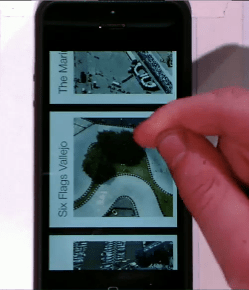Hackathon hacks can lead to fully fledged apps and companies. Other times they are intended to be nothing more than a great hack. 300ft is certainly that: a neat hack, built overnight at the TechCrunch Disrupt SF hackathon, which pulls in “close to live” aerial imaging from UAVs (aka drones) so the user can check how busy a prospective outdoor leisure location is before heading out.
The hack team behind 300ft deployed a fleet of drones over “the most popular places in San Francisco” — such as the marina and the piers — to pull in up-to-date imagery (hours old, rather than a real-time stream) to flesh out their app.
“You can dig into any one of these [several San Francisco locations] and view the latest data we’ve collected, oftentimes just a few hours old,” said 300ft hack team member Mark McSpaddan, also director of technology at travel technology company Sabrelabs, presenting the hack on stage (see video below). “Each image has time, geolocation and thanks to Weather Underground’s API weather data as well.”
The 300ft app is a neat hack in another sense, neatly combining aspects of the work done by the respective companies of the duo behind it, McSpaddan and Bret Kugelmass, co-founder of UAV imaging service startup Airphrame — with the former providing the travel tech, and the latter company delivering the eye in the sky capability.
300ft isn’t intended to become a business in its own right. But its creators are confident that services relying on real-time aerial imaging are very much coming down the pipe. Just don’t expect drones to be delivering pizza or tacos or burritos any time soon. “The pizza drone story is a completely unreasonable use of the applications of drones,” Kugelmass told TechCrunch in a backstage interview. “Same with the tacos, same with the burritos. That’s not happening.”
“It might happen at some point, but that’s in the distant, distant future,” he added when pressed. So sorry guys, no pizza-on-your-head deliveries just yet.
“This was just a great hack,” Kugelmass continued, discussing what the team had done with 300ft. “Airphrame’s business is separate. Sabre’s business is separate, this was just a great chance to come together and explore what’s possible in the future… UAV technology will be used for things other than the transport of heavy goods at first.”
Airphrame, which was founded more than a year ago, already has commercial customers for its UAV-powered aerial imaging capabilities although Kugelmass said it’s not currently disclosing customer names on confidentiality grounds. He did confirm that Airphrame’s customers are “commercial sector” entities though, not government agencies.
So, even though the 300ft hack itself isn’t going anywhere after today it likely anticipates a future wave of apps and services that will make commercial use of UAV technology. Military tech does have a habit of trickling down into commercial products, so expect to see more apps leveraging drone-powered near real-time aerial imaging capabilities in the not too distant (but potentially slightly dystopic) future — especially as the cost of the necessary hardware continues to come down.
Returning to the 300ft hack, it started as “some sketches and some things we had experimented with”, said McSpadden. “And then yesterday Bret sent his Airphrame crew out and they gathered a tonne of data [including the Americas’ Cup boat race].”
McSpadden added that one possible use-case for a drone-powered app in the travel sector could be to provide hotels with an information service they offer their customers, telling them which beaches are the least crowded, for instance. “A concierge with that kind of knowledge would be much more valuable,” he added.
